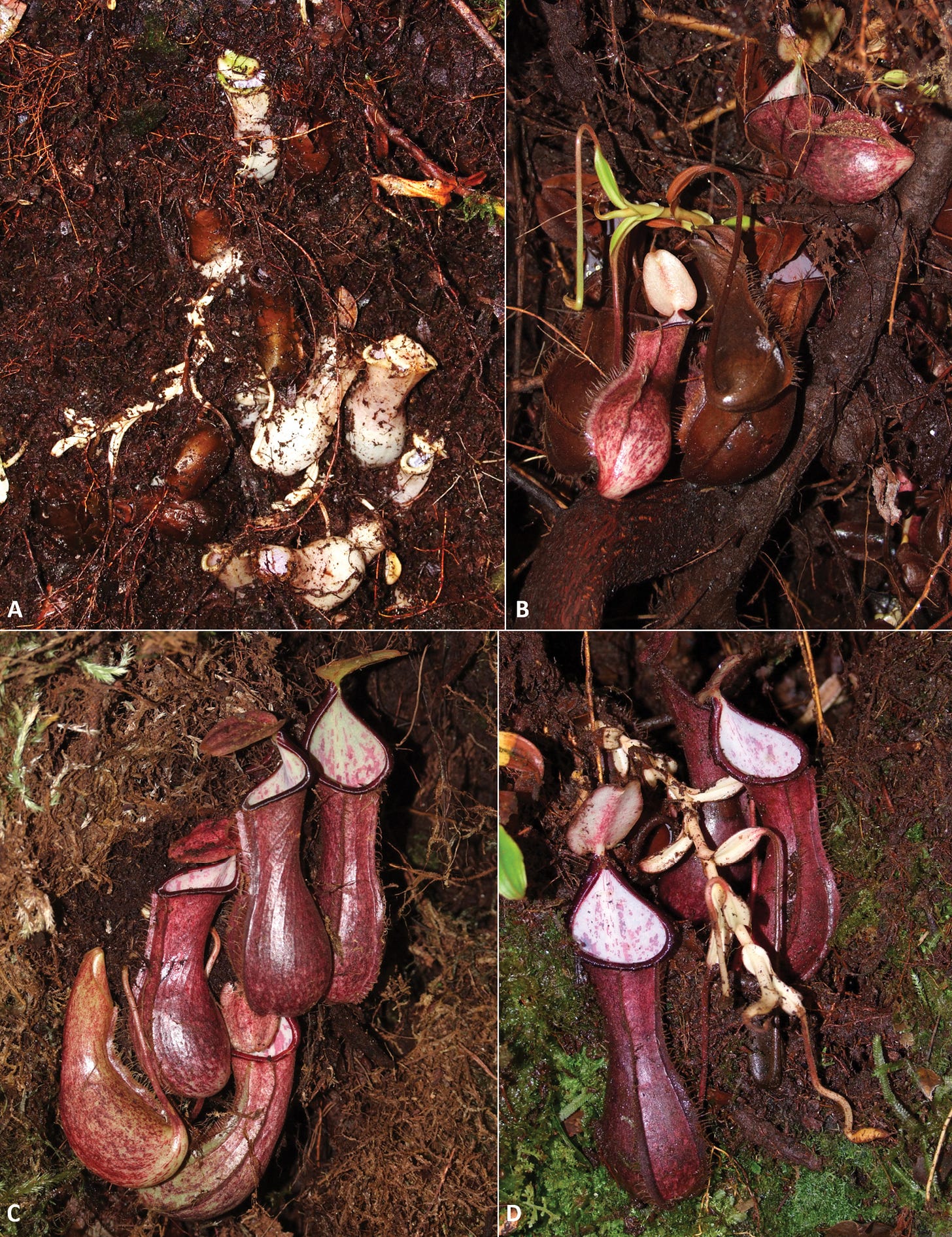A dirty, low down pitcher plant
“If this is not Helen’s Nepenthes, it certainly will be for all botanists. What botanist would not be filled with admiration if, after a long journey, he should find this wonderful plant. In his astonishment past ills would be forgotten when beholding this admirable work of the Creator!”
So wrote Linnaeus, comparing a pitcher plant to the potion, Nepenthes pharmakon, given to Helen by an Egyptian queen in Homer’s Odyssey.
Nepenthes pudica: (A) detail of lower pitchers excavated from the soil; (B) lower pitchers in a cavity under tree roots–note greening of phyllodia formed in presence of low light; (C) lower pitchers revealed under a moss mat; (D) lower pitchers extracted from a cavity–note achlorophyllous shoot and reduced phyllodia formed in total darkness. Photographs by M. Dančák. Source: Dančák et al. (2022), PhytoKeys 201:77-97.
I’m pretty sure I’m not under the influence of a potion, but I am in awe at the very idea of carnivorous plants. The genus Nepenthes includes about 170 species of pitcher plants. The common name ‘pitcher plant’ is shared by similar looking plants in several other lineages, including three genera in the New World family Sarraceniaceae, the Australian species Cephalotus follicularis (classified in its own family), and certain species of bromeliads.
Today, we meet Nepenthes pudica, a recently discovered species that is a strange plant among many strange plants. There are species of Nepenthes with hollow tendrils in which ants build nests. One that uses a sugary secretion to attract tree shrews which, while lapping up this tasty treat, defecate into the pitcher, its feces supplying fifty to one hundred percent of the plant’s foliar nitrogen uptake. Yet another species is symbiotic with Hardwicke’s woolly bat. The bat roosts in the pitcher by day where it, too — by which I refer to its number two — provides nitrogen in similar fashion.
Beyond symbionts, there are an array of species, called infauna or nepenthebionts, that spend at least some of their lives living in the pitchers. These include midge and mosquito larvae, spiders, ants, mites, and at least one crab. And, of course, there’s a long list of invertebrates on the pitcher plant’s buffet menu.
Nepenthes are widespread, with species found from Madagascar and the Seychelles in the west, Australia and New Caledonia in the south, and India and Sri Lanka in the north, with species also in south China, Indonesia, and Malaysia. But the greatest concentration of species are found in Borneo, Sumatra, and the Philippines. They occur in both hot, humid, lowland habitats and montane tropical locations with warm days and cool nights.
From their shallow root system rises a climbing stem. The pitcher itself is a highly modified leaf that starts out as a small bud, ultimately expanding into a tubular or globular trap. In addition to the viscous liquid inside the trap is a slippery, waxy surface on the upper inside of the lip that insects slide down to their doom and that makes escape nearly impossible. Digestive glands secrete mucilage, acids, and no fewer than twenty-nine proteins, including digestive enzymes. There are also metabolites that kills fungi and bacteria that keep microbes from consuming the nutrients being released as prey are digested. Nepenthes produce two distinct kinds of pitchers. Lower traps typically are found at ground level while upper traps are, you guessed it, higher up on the plant. The upper traps tend to be smaller and different in color and form, and the two traps catch different prey. Diets most commonly consist of insects, but larger species of the genus sometimes trap larger prey, including lizards and rats.
Nepenthes have quite a history. They first show up in a book about Madagascar by a French colonial governor in 1658. And after Sir Joseph Banks returned specimens to London, interest in pitcher plants grew. By the 1880s it was a bit of a craze some have called the Golden Age of Nepenthes.
The new species is the first carnivorous plant with subterranean gravity operated pitcher traps. A few other carnivorous plants have underground structures, but they use other method to snare prey and are not true pitfalls. The new species was found near trees with branched root structure that formed cavities beneath a layer of moss. Where such cavities did not exist, pitchers were produced in soil, deep litter, or beneath a carpet of moss. The fragile architecture of the traps is reinforced by somewhat thicker walls. Documented prey includes oribatid mites and a few families of beetles. But their main diet appears to be a Crematogaster ant, a genus previously shown to be associated with pitcher plants.
The new species joins a list of about forty Nepenthes found in Borneo, famous for its fantastic biodiversity with many endemic species. It was discovered in lower montane rainforest in North Kalimantan, Indonesia. Nepenthes pudica is just one of many recent surprises given up by Borneo that deserves to be protected, explored, and valued for its world-class biodiversity.
Sadly, the Borneo rainforest that has been an engine of species diversification for 140 million years is among the most rapidly disappearing in the world. From 2002-2019, the Indonesia portion of Borneo lost 10.7 million hectares of tree cover, including about 4 million hectares of primary forest, with logging and palm oil plantations largely to blame.
Further Reading
Dančák et al. (2022) First record of functional underground traps in a pitcher plant: Nepenthes pudica (Nepenthaceae), a new species from North Kalimantan, Borneo. PhytoKeys 201: 77-97.
Acknowledgment
I thank Dr. Dančák for permission to reproduce the plate of his photographs.




